Abstract
Clostridium sp. strain S1, an unnamed bile acid-desulfating strain from rat intestinal microflora (S.M. Huijghebaert, J. A. Mertens, and H. J. Eyssen, Appl. Environ. Microbiol. 43:185-192, 1982), was examined for its ability to desulfate different bile acid sulfates and steroid sulfates in growing cultures. Clostridium sp. strain S1 desulfated the 3 alpha-monosulfates of chenodeoxycholic, deoxycholic, and cholic acid, but not their 7 alpha- or 12 alpha-monosulfates. Among the 3-sulfates of the 5 alpha- and 5 beta-bile acids, only bile acid-3-sulfates with an equatorial sulfate group were desulfated. Hence, Clostridium sp. strain S1 desulfated the 3-sulfates of bile acids with a 3 alpha, 5 beta-, a 3 beta, 5 alpha- or a 3 beta, delta 5-structure. In contrast, the bile acid-3-sulfates with a 3 beta, 5 beta- or a 3 alpha, 5 alpha-structure were not desulfated. In addition, Clostridium sp. strain S1 did not hydrolyze the equatorial 3-sulfate esters of C19 and C21 steroids and cholesterol or the phenolic 3-sulfate esters of estrone and estradiol. 23-Nordeoxycholic acid with a C-23 carboxyl group was also not desulfated, in contrast to the 5 beta-bile acid 3 alpha-sulfates with a C-24 or C-26 carboxyl group. Therefore, the specificity of the sulfatase of Clostridium sp. strain S1 is related to the location of the sulfate group on the bile acid molecule, the equatorial orientation of the sulfate group, and the structure of the C-17 side chain, its carboxyl group, and chain length.
Full text
PDF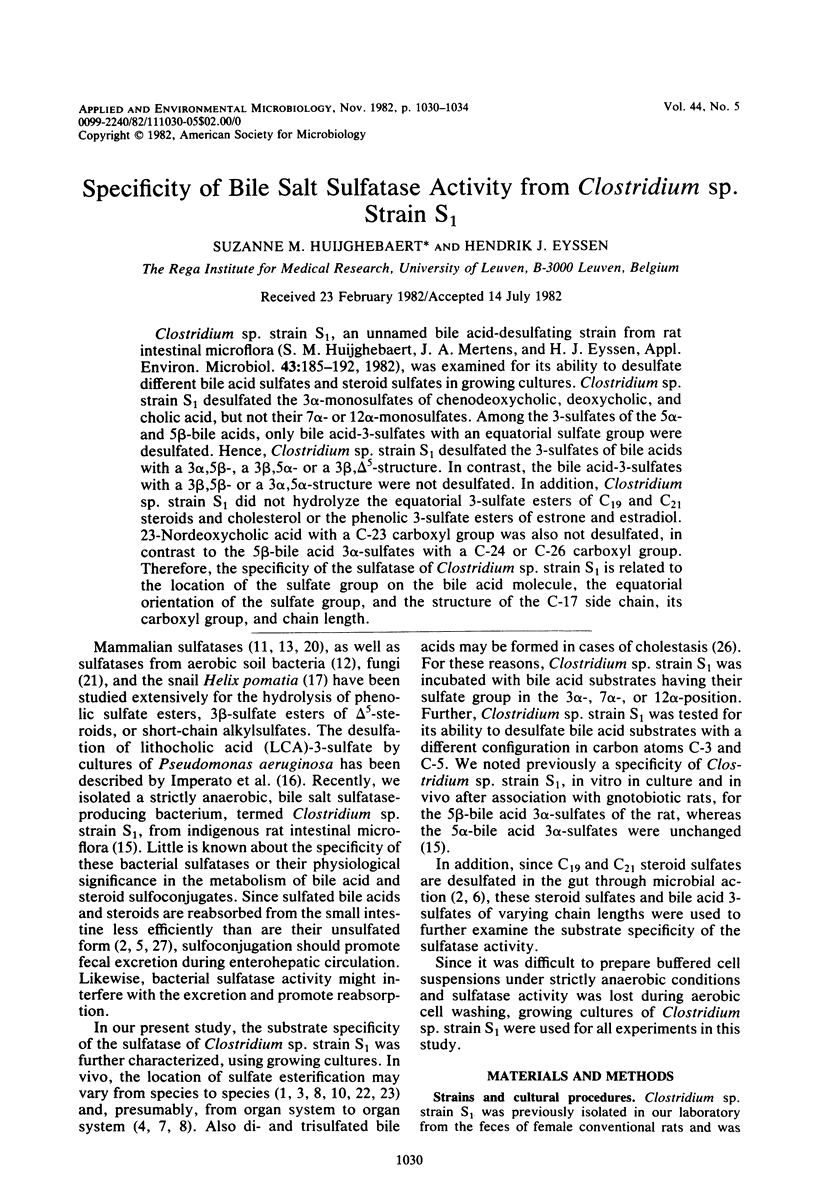
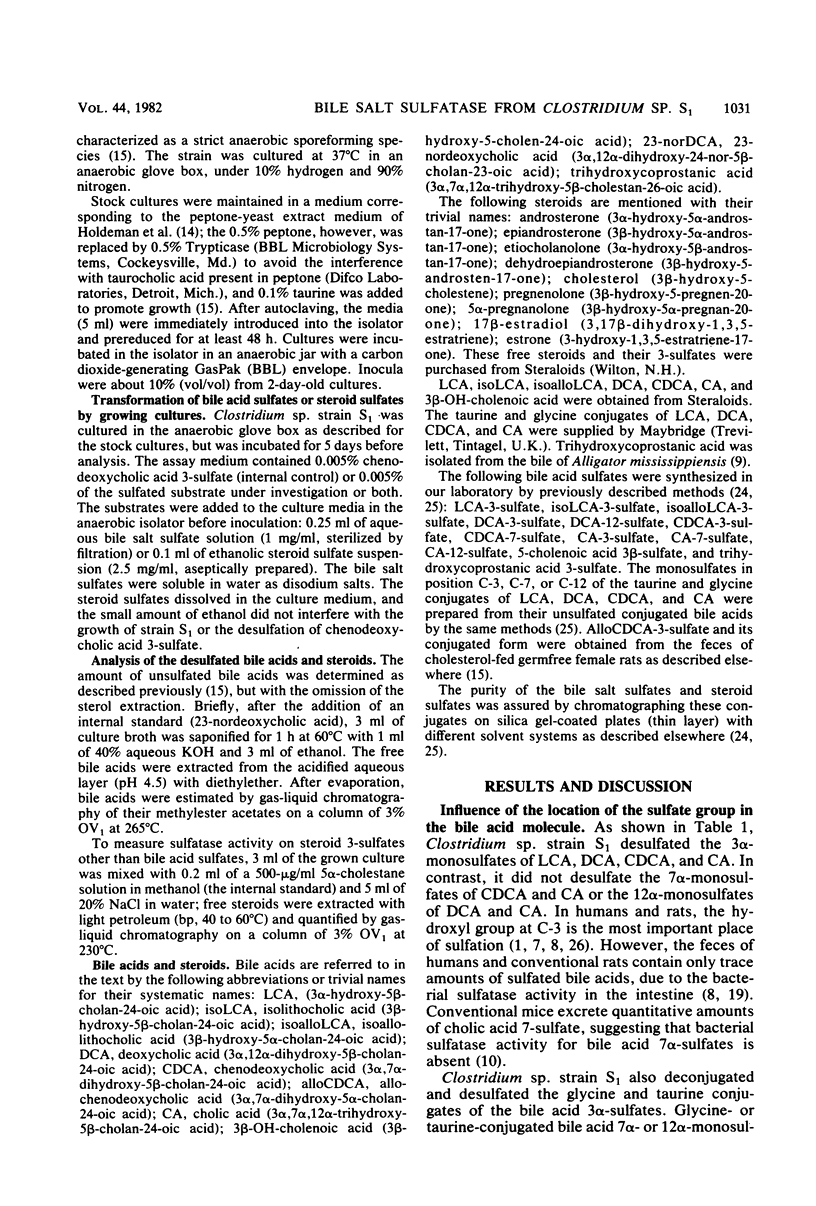
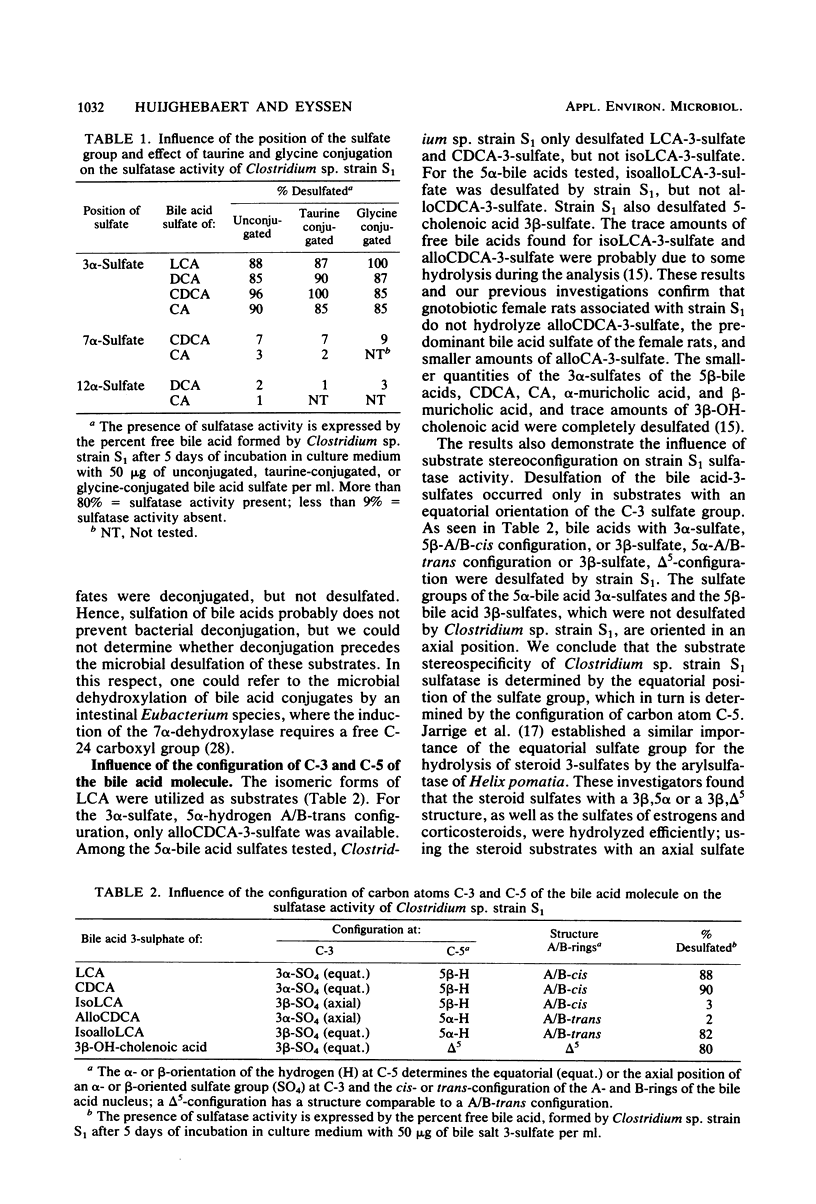
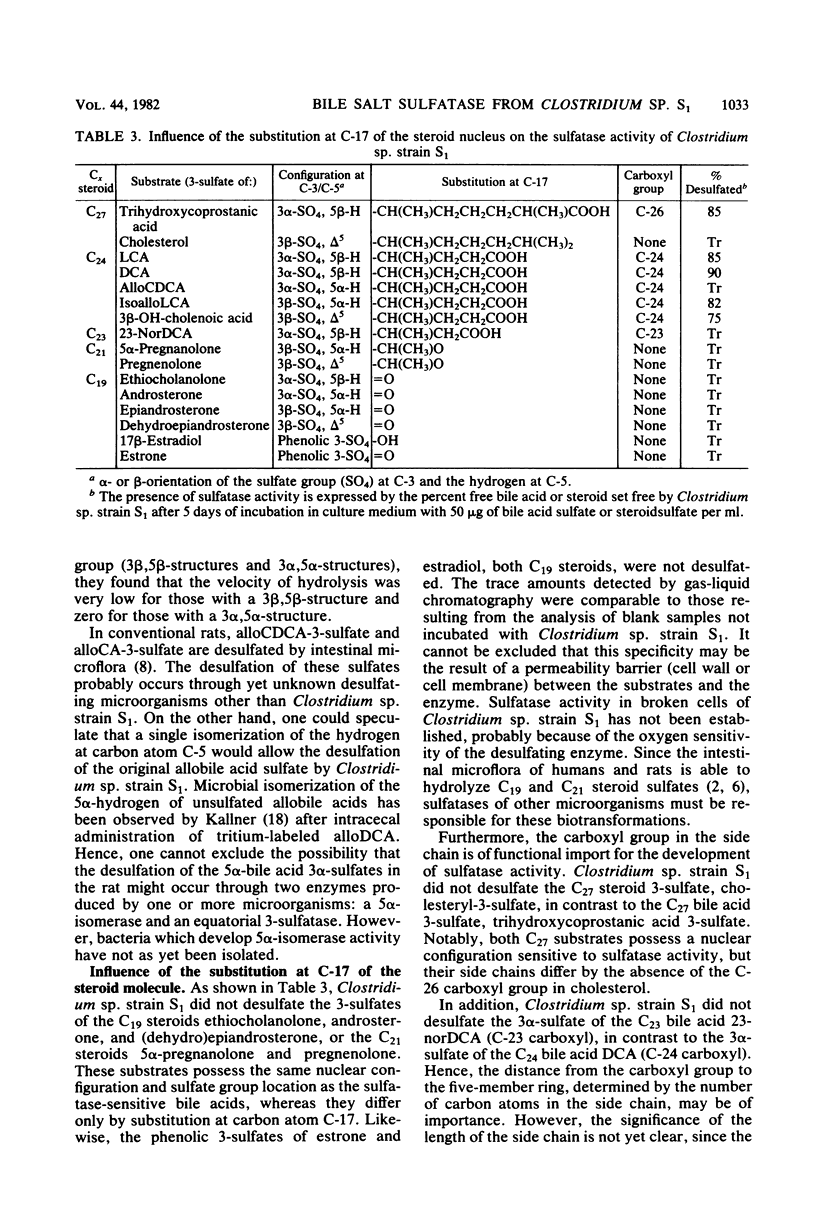
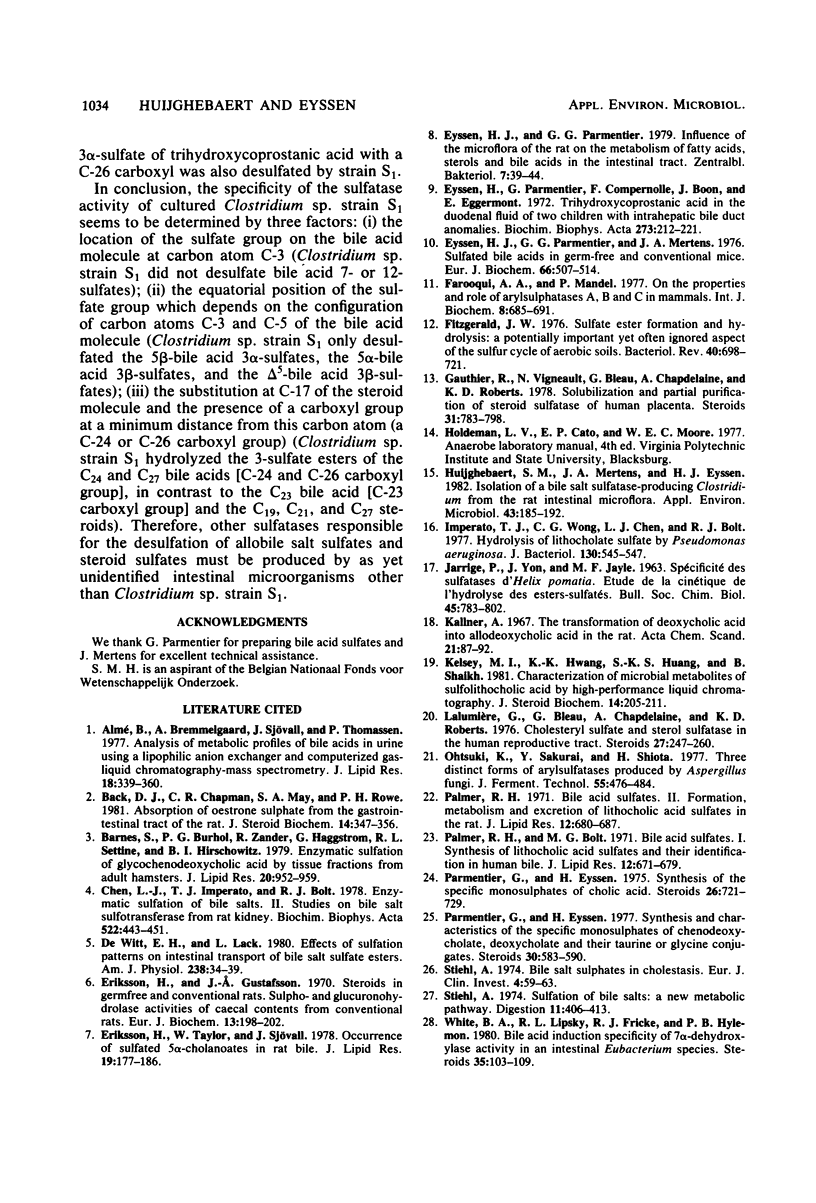
Selected References
These references are in PubMed. This may not be the complete list of references from this article.
- Almé B., Bremmelgaard A., Sjövall J., Thomassen P. Analysis of metabolic profiles of bile acids in urine using a lipophilic anion exchanger and computerized gas-liquid chromatorgaphy-mass spectrometry. J Lipid Res. 1977 May;18(3):339–362. [PubMed] [Google Scholar]
- Back D. J., Chapman C. R., May S. A., Rowe P. H. Absorption of oestrone sulphate from the gastrointestinal tract of the rat. J Steroid Biochem. 1981 Apr;14(4):347–356. doi: 10.1016/0022-4731(81)90153-9. [DOI] [PubMed] [Google Scholar]
- Barnes S., Burhol P. G., Zander R., Haggstrom G., Settine R. L., Hirschowitz B. I. Enzymatic sulfation of glycochenodeoxycholic acid by tissue fractions from adult hamsters. J Lipid Res. 1979 Nov;20(8):952–959. [PubMed] [Google Scholar]
- Chen L. J., Imperato T. J., Bolt R. J. Enzymatic sulfation of bile salts. II. Studies on bile salt sulfotranferase from rat kidney. Biochim Biophys Acta. 1978 Feb 10;522(2):443–451. doi: 10.1016/0005-2744(78)90077-3. [DOI] [PubMed] [Google Scholar]
- Eriksson H., Gustafsson J. A. Steroids in germfree and conventional rats. Sulpho- and glucuronohydrolase activities of caecal contents from conventional rats. Eur J Biochem. 1970 Mar 1;13(1):198–202. doi: 10.1111/j.1432-1033.1970.tb00919.x. [DOI] [PubMed] [Google Scholar]
- Eriksson H., Taylor W., Sjövall J. Occurrence of sulfated 5alpha-cholanoates in rat bile. J Lipid Res. 1978 Feb;19(2):177–186. [PubMed] [Google Scholar]
- Eyssen H. J., Parmentier G. G., Mertens J. A. Sulfate bile acids in germ-free and conventional mice. Eur J Biochem. 1976 Jul 15;66(3):507–514. doi: 10.1111/j.1432-1033.1976.tb10576.x. [DOI] [PubMed] [Google Scholar]
- Eyssen H., Parmentier G., Compernolle F., Boon J., Eggermont E. Trihydroxycoprostanic acid in the duodenal fluid of two children with intrahepatic bile duct anomalies. Biochim Biophys Acta. 1972 Jun 26;273(1):212–221. doi: 10.1016/0304-4165(72)90209-7. [DOI] [PubMed] [Google Scholar]
- Fitzgerald J. W. Sulfate ester formation and hydrolysis: a potentially important yet often ignored aspect of the sulfur cycle of aerobic soils. Bacteriol Rev. 1976 Sep;40(3):698–721. doi: 10.1128/br.40.3.698-721.1976. [DOI] [PMC free article] [PubMed] [Google Scholar]
- Gauthier R., Vigneault N., Bleau G., Chapdelaine A., Roberts K. D. Solubilization and partial purification of steroid sulfatase of human placenta. Steroids. 1978 Jun;31(6):783–798. doi: 10.1016/s0039-128x(78)80043-9. [DOI] [PubMed] [Google Scholar]
- Huijghebaert S. M., Mertens J. A., Eyssen H. J. Isolation of a bile salt sulfatase-producing Clostridium strain from rat intestinal microflora. Appl Environ Microbiol. 1982 Jan;43(1):185–192. doi: 10.1128/aem.43.1.185-192.1982. [DOI] [PMC free article] [PubMed] [Google Scholar]
- Imperato T. J., Wong C. G., Chen L. J., Bolt R. J. Hydrolysis of lithocholate sulfate by Pseudomonas aeruginosa. J Bacteriol. 1977 Apr;130(1):545–547. doi: 10.1128/jb.130.1.545-547.1977. [DOI] [PMC free article] [PubMed] [Google Scholar]
- JARRIGE P., YON J., JAYLE M. F. SP'ECIFICIT'E DES SULFATASES D'HELIX POMATIA. ETUDE DE LA CIN'ETRIQUE DE L'HYDROLYSE DES ESTERS-SULFAT'ES. Bull Soc Chim Biol (Paris) 1963 Aug 31;45:783–802. [PubMed] [Google Scholar]
- Kallner A. The transformation of deoxycholic acid into allodeoxycholic acid in the rat. Bile acids and steroids.174. Acta Chem Scand. 1967;21(1):87–92. doi: 10.3891/acta.chem.scand.21-0087. [DOI] [PubMed] [Google Scholar]
- Kelsey M. I., Hwang K. K., Huang S. K., Shaikh B. Characterization of microbial metabolites of sulfolithocholic acid by high-performance liquid chromatography. J Steroid Biochem. 1981 Feb;14(2):205–211. doi: 10.1016/0022-4731(81)90175-8. [DOI] [PubMed] [Google Scholar]
- Lalumière G., Bleau G., Chapdelaine A., Roberts K. D. Cholesteryl sulfate and sterol sulfatase in the human reproductive tract. Steroids. 1976 Feb;27(2):247–260. doi: 10.1016/0039-128x(76)90101-x. [DOI] [PubMed] [Google Scholar]
- Palmer R. H. Bile acid sulfates. II. Formation, metabolism, and excretion of lithocholic acid sulfates in the rat. J Lipid Res. 1971 Nov;12(6):680–687. [PubMed] [Google Scholar]
- Palmer R. H., Bolt M. G. Bile acid sulfates. I. Synthesis of lithocholic acid sulfates and their identification in human bile. J Lipid Res. 1971 Nov;12(6):671–679. [PubMed] [Google Scholar]
- Parmentier G., Eyssen H. Synthesis and characteristics of the specific monosulfates of chenodeoxycholate, deoxycholate and their taurine or glycine conjugates. Steroids. 1977 Nov;30(5):583–590. doi: 10.1016/0039-128x(77)90049-6. [DOI] [PubMed] [Google Scholar]
- Parmentier G., Eyssen H. Synthesis of the specific monosulfates of cholic acid. Steroids. 1975 Dec;26(6):721–729. doi: 10.1016/0039-128x(75)90105-1. [DOI] [PubMed] [Google Scholar]
- Stiehl A. Bile salt sulphates in cholestasis. Eur J Clin Invest. 1974 Feb;4(1):59–63. doi: 10.1111/j.1365-2362.1974.tb00373.x. [DOI] [PubMed] [Google Scholar]
- Stiehl A. Sulfation of bile salts: a new metabolic pathway. Digestion. 1974;11(5-6):406–413. doi: 10.1159/000197609. [DOI] [PubMed] [Google Scholar]
- White B. A., Lipsky R. L., Fricke R. J., Hylemon P. B. Bile acid induction specificity of 7 alpha-dehydroxylase activity in an intestinal Eubacterium species. Steroids. 1980 Jan;35(1):103–109. doi: 10.1016/0039-128x(80)90115-4. [DOI] [PubMed] [Google Scholar]


